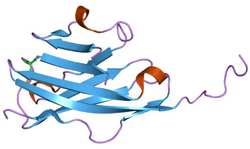October 1, 2014 /
Researchers are working to refine a cell-based assay that more accurately identifies antibodies for myelin oligodendrocyte glycoprotein (MOG) in the serum of patients with neuromyelitis optica spectrum disorders. Some think that anti-MOG-positive patients may even represent a distinct demyelinating disease.
Researchers are working to refine a cell-based assay that more accurately identifies antibodies for myelin oligodendrocyte glycoprotein (MOG) in the serum of patients with neuromyelitis optica spectrum disorders. Some think that anti-MOG-positive patients may even represent a distinct demyelinating disease.
CYNTHIA MCKELVEY
Scientists understand neuromyelitis optica spectrum disorders (NMOSD) far better now than when they were first described as Devic’s disease in 1894. NMOSD is an umbrella category including optic neuritis, myelitis, and acute disseminated encephalomyelitis (ADEM). While researchers understand NMOSD far better than they did even 10 years ago, so much remains obscured.
As we described in our four-part News Synthesis on NMO, researchers and clinicians believed NMO to be a subtype of multiple sclerosis until 2005, when researchers discovered a biomarker for the disease in an antibody that attacks a protein in astrocytes known as aquaporin-4. AQP4 is an integral membrane protein that helps conduct water through the cell membrane. According to Brian Weinshenker, M.D., of the Mayo Clinic in Minnesota, roughly 70% to 80% of adult NMOSD patients test positive for AQP4. Most of them are women.
Unfortunately, anti-AQP4-positive patients usually receive a dire prognosis. Relapses and disabilities are common, while recovery from the attacks tends to be incomplete. The body seems to attack the optic nerves and spinal cord, leading to problems in vision and walking.

~~~~~~~~~~~~~~~~~~~~
.
WATCH OUR Multiple Sclerosis recorded
EDUCATIONAL VIDEOS by Topic:
EDUCATIONAL VIDEOS by Topic:
click:: www.youtube.com/msviewsandnews
.
Visit our MS Learning Channel on YouTube: http://www.youtube.com/msviewsandnews
Stay informed with MS news and information - Sign-up here
For MS patients, caregivers or clinicians, Care to chat about MS? Join Our online COMMUNITY CHAT



